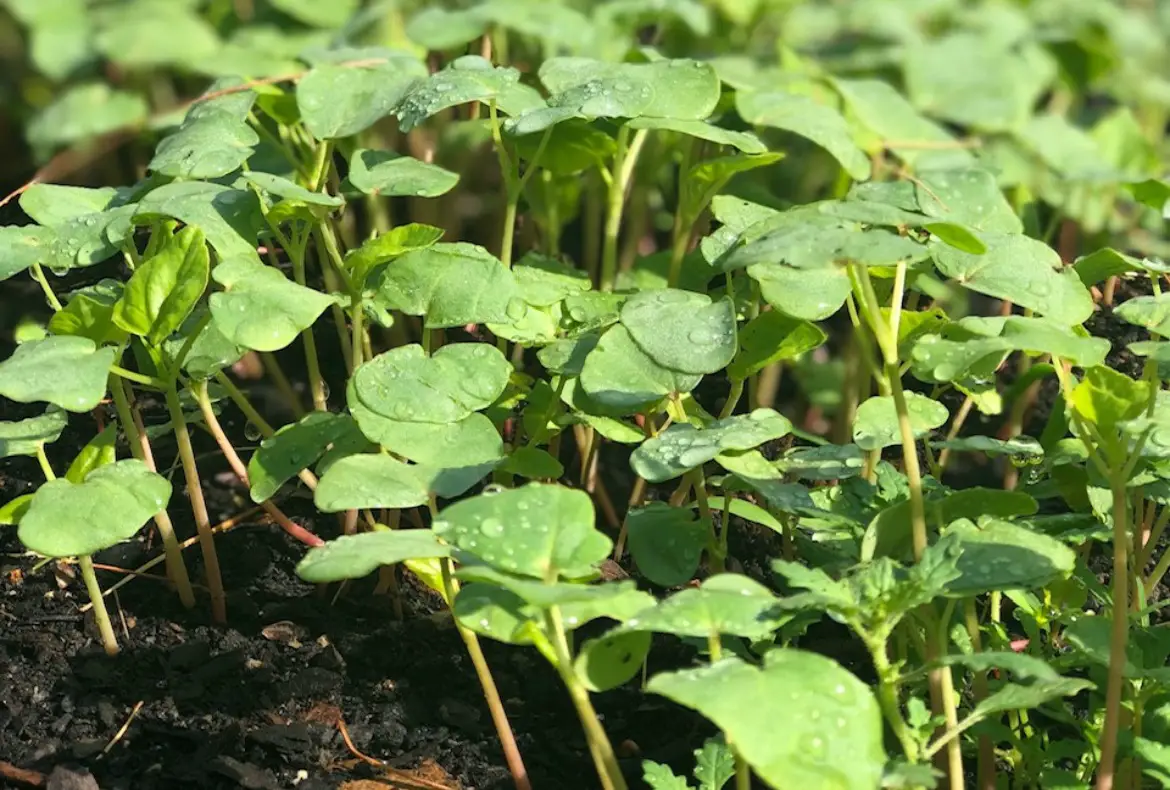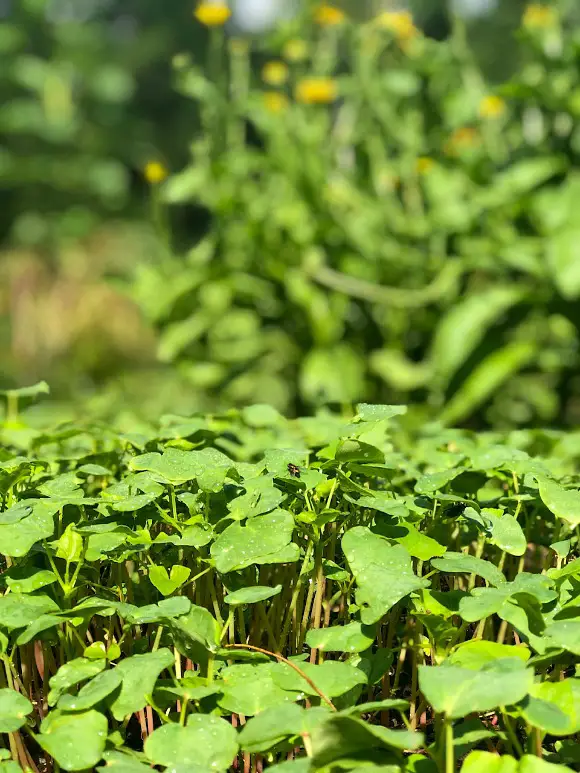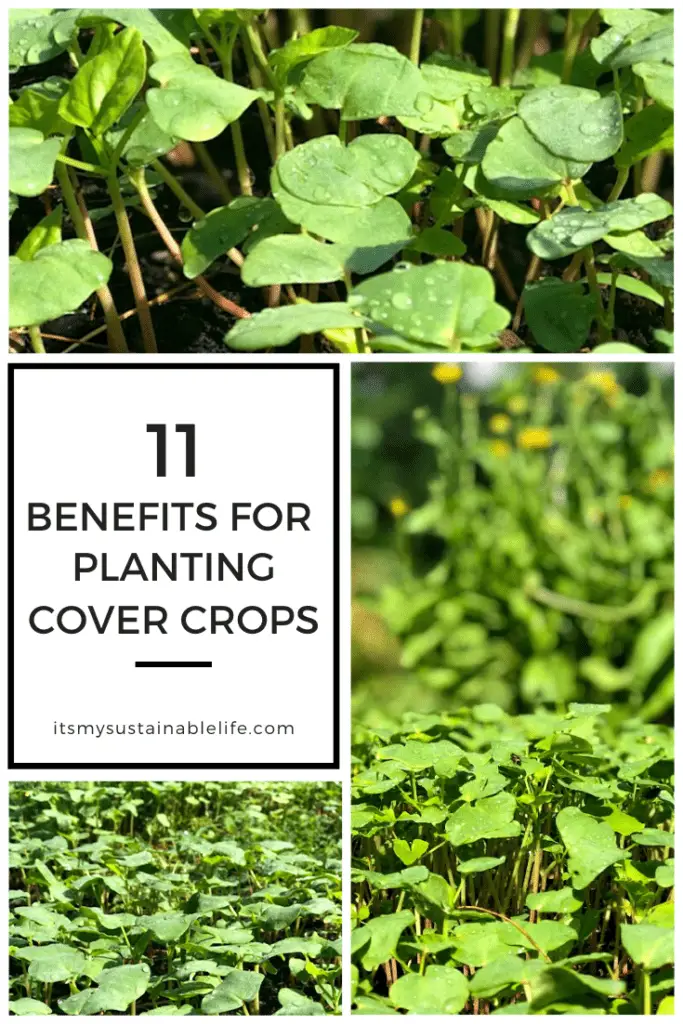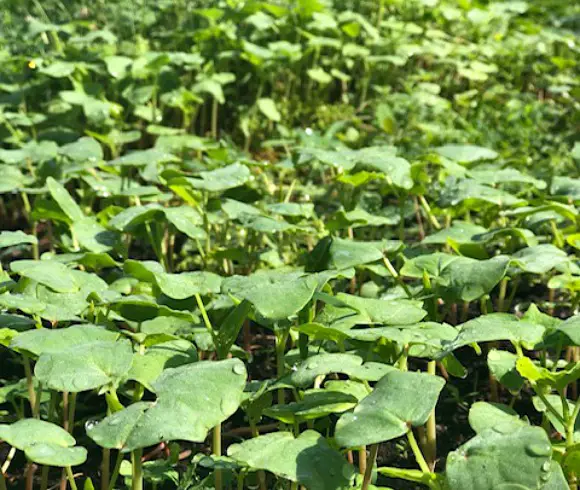Cover crops, aka green manure, are an inexpensive way to build the quality of the soil in your garden. Planting fall and winter cover crops consisting of legumes, grains, or grasses directly into your garden offer the soil the nutrients and organic matter it may be lacking and so much more.
This post may contain affiliate links at no additional cost to you. By making your purchases through the links on this website, IMSL may make a small percentage at no direct cost to you. IMSL only promotes products we use & truly believe in. Please refer to my Privacy & Disclosures for further information. IMSL thanks you for your support!
Gardeners know that in order to increase harvest yields in the vegetable garden, successful flowers in the perennial garden, and amazing herb production in the herb garden, success largely depends on the health of the soil. Soil needs to be fed. Offering garden soil the organic matter it needs to maintain a healthy balance of bacteria & fungi that earthworms & other forms of life within the soil feed on is imperative to creating healthy, fertile soil.
As organic matter is quickly consumed by living organisms within the soil, planting cover crops ensures a much needed continual supply of the organic matter needed when planted routinely. Other inputs consisting of composts, manure, sawdust, & bark dust all offer good sources of organic matter as well.
KNOW YOUR SOIL
When choosing which cover crop to plant, it is important that you know your soil. Determining what type of soil you have and its pH levels is a good first step. Most state extensions offer soil testing. A great resource of state soil testing services can be found HERE.
Nitrogen is an important component of healthy yields. Knowing your garden and watching for telltale signs of deficiency are key to maintaining balance. According to The Permaculture Research Institute, visual symptoms of nitrogen deficiencies include:
The Permaculture Research Institute
• Pale green to yellow leaves: This is a consequence of insufficient production of chlorophyll in leaves. Nitrogen is a key component of chlorophyll in plants therefore its deficiency reflects in chlorophyll production. Chlorophyll is the substance responsible for the green pigmentation in leaves and stems.
• Stunted plant growth: A visible sign in a nitrogen deficient soil is the stunted growth of plants. Nitrogen is necessary for cell division and enlargement. Shortage of this nutrient slows growth and development.
• Reduced crop yield and protein content: This is a consequence of poor growth and development during the plants life cycle. Low protein is especially devastating in grain crops such as bread wheat; where the grain quality is judged by the protein content.
TYPES OF COVER CROPS
According to the Rodale Institute, the best cover crops, especially for a no-till garden such as ours, include the following characteristics:
– They produce a lot of biomass, at least 3 tons above-ground dry matter per acre.
Rodale Institute
– They are readily killed by mowing, rolling or other mechanical means, forming a mulch.
– Their residues are sufficient to provide effective weed control.
– They provide habitat for natural enemies of vegetable crop pests.
– They have favorable (or at least neutral) effect on levels of available soil N, P and K.
– They do not suppress the vegetable through chemical (allelopathic) or microbial effects.
– They do not present serious weed, pest, disease or other management problems.
The Sustainable Agricultural Research & Education, aka SARE, has a wonderful synopsis on how to select the best cover crop for your needs. They advise:
Clarify your primary needs
SARE
Identify the best time and place for a cover crop in your system
Test a few options
SARE also advises to “narrow your goals to one or two primary and perhaps a few secondary goals” as this “will greatly simplify your search for the best cover species”. What are a few of the goals they recommend for cover crops? Your choice of green manure should provide the following:
Provide nitrogen
SARE
Add organic matter
Improve soil structure
Reduce soil erosion
Provide weed control
Manage nutrients
Furnish moisture-conserving mulch
Common cover crops are as follows:
- Annual Rye Grasses – Utilizing a thick mat of these grasses assists in erosion prevention & reducing weed totals. These grasses are not hardy and die over winter. It should be noted that the chemicals released as the grasses decompose may inhibit small seed from germinating, such as carrot or lettuces.
- Buckwheat & Rapeseed – Grow quickly in the warmer months and help to smother weeds. Buckwheat flowers are an amazing source of bee nectar (why we grew this crop). Self-seeding if allowed. Buckwheat has no frost tolerance, rapeseed may survive mild winters.
- Clovers – This somewhat winter hardy plant may survive winter and is known to fix nitrogen levels. The large variety known as Ladino makes an exceptional cover crop.
- Hairy Vetch & Alfalfa – These plants also fix nitrogen and are winter hardy.
- Peas, Beans, & Soybeans – Known as legumes, these plants fix nitrogen and are edible crops. After harvesting, turn the plants under.
- Winter Wheat & Winter Rye – These grains are cold & winter hardy and are good for areas you will be planting warm-weather plants such as tomatoes, peppers, & squash. Turn the green manure under early spring (mid-May) and then plant your warm-weather plants. Rye can develop a tough root system which can make planting difficult.
It is often beneficial to often combine cover crop seed. For instance, you can combine a legume such as peas along with a grass such as rye to encourage nitrogen production and reduce weed growth.
One of the best sources of organic & heirloom varieties of cover crops is True Leaf Market. Their seed quality and germination rate are bar none. We have had wonderful success here on the hill using seed from this company and we highly recommend giving them a try.
TOP 12 BENEFITS OF COVER CROPS
Cover crop benefits are many. In addition to the ones listed above, here are our top 11.
- Prevents soil erosion
- Improves soils nutrient content, physical makeup, & biological makeup
- Increases nutrient supply and feeds organic matter to living organisms within the soil
- Improves soils water availability; both water infiltration and the soils holding capacity
- Breaks pest cycles
- Adds organic matter to the soil
- Breaks soil consistency (compacted soil)
- Increased crop yields
- Decreases workload (suppresses weeds)
- Feeds the bees when using certain flowering crops such as buckwheat
- An economical way to improve soil organically
WHEN TO PLANT COVER CROPS
Cover crops can be planted throughout the growing season. Here are a few suggestions for seasonal crops you can plant and when to till. Always follow the instructions on your seed packets for sowing dates.
BEST SUMMER COVER CROPS
A few of the best crops to plant in the warmer months include alfalfa, barley, buckwheat, clover, fava beans, and oats. Most need to be tilled under come the cooler months of fall.
BEST FALL COVER CROPS
A few varieties to sow in the fall include Australian field peas, barley, garden peas, oats, annual rye, hairy vetch, and winter wheat. The majority of these varieties will be left over the winter and turned under in the spring.
BEST COVER CROPS FOR IMPROVING NITROGEN
When it’s nitrogen you are looking to add to your soil look to legumes such as vetch, Australian winter peas, and clovers. These varieties capture nitrogen from the air and transfer it into soil N.
HOW TO PLANT COVER CROPS
Planting occurs mid-August through September leaving plenty of time for growth before cold weather arrives. At least a 4-week window of growth should be aimed for. If you have a garden filled with fall crops still, consider planting cover crops along the sides of pathways, walkways and between rows.
Generally speaking, to plant large-seeded cover crops such as peas, vetch, and wheat, plan on planting in shallow furrows closely together. Small seed such as rye and buckwheat can be broadcast (as you would grass seed) and lightly covered or raked over. If your soil is dry, irrigate and keep moist until germination has occurred.
Come springtime as soon as the ground has thawed and drained sufficiently for working it, turn the crop under. To allow for sufficient decomposition, plan on turning under the crop at least 3 weeks prior to spring planting time. If the cover crop is too tall to turn under easily, mow and then turn. Do not allow any cover crop to go to seed as many such as vetch will spread and turn to weeds. Hopefully, not what you are aiming for 🙂 .
Creating and maintaining healthy soil is a continuing necessity. Supplying sufficient organic matter through annual planting of cover crops will feed the soil and its organisms the necessary nutrients to create the biodiversity needed to ultimately feed you.
Do you already plant cover crops? What are your favorites to plant and why? Get the conversation going by commenting below. Happy planting!
Love, Light, & Laughter ~






51 comments
Thank you for sharing this helpful post at Embracing Home and Family! I am featuring you this Friday!
Thank you Jennifer!
I had forgotten about this tactic. I am sending over to my son!
********************************************************
This is great information! Cover crops are SO important! I have been wondering though…Is it normal for people to cover crop in their raised beds? Most posts on cover crops are for in-the-ground gardening, but I see how this could be valuable in raised beds. I’ll be trying it soon in mine!
I did in mine last year. Not sure if I’m normal or not, LOL, but anywhere I grow repeatedly figured it could use the added nutrients as well. Thank you for reading & sharing your thoughts!
I love these green manure ideas. I am growing red beans & they are thriving! The best cover crops for each season info was really helpful. Thanks for this! Saving it for later reference.
I’m so glad you found the article useful Sarah, and thank you for reading 🙂
I’ve grown phacalia as a green manure and when left to flower it is so beneficial for bees. My garden is suffering a bit from neglect at the moment due to my having an injury but hopefully I’ll be back on track soon and revisiting the idea of green manures. #GoingGreen
I’ve heard a lot about the benefits of using a cover crop, but never tried it. Honestly, I didn’t know what would qualify as a cover crop. Thanks for sharing your tips!
Hi Suzan!
I need to get busy next year and plant some cover crops…my garden really needs it! Thanks so much for sharing with us on Farm Fresh Tuesdays! I hope you’ll come back this evening or tomorrow for our 3 Weeks of Thanksgiving Special Hop Event!
Great info! And I certainly understand the value. I have a small raised bed garden that I plant by the square foot so it’s very full. And then large flower and herb gardens that are full of growing plants from spring until late fall. Sounds like I need to find a winter crop that would thrive over the winter in Missouri.
They would certainly benefit, Cindy! The following would be great to grow and then overwinter til spring turn-under for your area: crimson clover, Austrian winter pea, oats, and wheat. Thanks so much for reading!
Wow this was intrestining I guess I never really thought about all of the different things that go into a crop.
Thank you for sharing at #OverTheMoon. Pinned and shared. Have a lovely week. I hope to see you at next week’s party too!
Cover crops! I never knew any of this! Thanks!
Wow great overview post of the topic. I have been using cover crops, just in winter at my allotment for a few years. I use a mix of Rye Grass, Fodder Radish, Alfalfa and another grass. I mind they are great for building up bio mass in the spring for mulch. They look great over winter and keep all the nutrients and moisture in the soil. Thank you or sharing #GoingGreenLinky
What a great combination! I bet they do give wonderful visual interest during the winter months. Thanks for sharing your info!
This is a great tip! Thank you for sharing.
So much great information! Sounds like I need to test my garden soil! Thanks for the post! 🙂
Thanks for sharing this! What an invaluable amount of information! I have 3 large gardens and by the time late fall rolls around I’m done with them and don’t even think twice about cover crops…but now I do!
This is so full of great information on keeping soil healthy. I did not realize there was a test for testing your soil-shows I don’t have a green thumb 🙂 Thanks for sharing!
This is great information, all I knew was what to do in the warmer months. I had no idea what all that could be completed in the colder ones.
This is so cool! I love anything DIY like this because fertilizer isn’t always a good thing
I could not agree more Haley! Thanks for stopping by.
THis is such great information! Thank You as always for sharing inspiration! I am working to start a small garden and have it be successful! Thanks again!
This post is very valuable for me! Thanks so much for sharing all this great info!
I can really use this information! I am starting to get back into gardening and rather than winging it like i used to I would like to understand the science more! Thanks!
Glad you found this useful, Tricia!
Never heard of this – one of these days will get my yard presentable and keep this in mind!
so here’s the plan… I’m going to figure out how to move to the east coast and then i want to hire you to build me a beautiful medicine garden. 🙂 and we will drink home made tea and dry things and all will be well in the world.
Let me know when you get here 🙂
You always provide such informative posts packed with lots of great details. This is another post I’m pinning!
Thanks for pinning, Jen!
Awesome info here! Thank you for sharing!! Will be helpful for my spring planning 😉
So much great information here! Thank you for sharing. I’ve been gardening for YEARS but learned so much from you in this post!
Love this in so many ways…I have gone from having a beautiful raised bed organic veg garden about 5 years ago, to having scallions and overgrown sweet potatoes that happened to grown on accident! This post is inspiring me to get my hands dirty and start growing my own food again…I work for an organic farmer on the weekends and the grow cover crops in their offseason. It’s a must! Thanks for this!
Hope you get your garden in next growing season…at least you had a few surprises this year 🙂
I had my first garden at our house this summer, and look forward to expanding it. I will have to focus on how to prep it over the winter so the soil is healthy in the spring. Thanks!
Thanks for the tips, I may have to go plant some winter wheat real quick…
With the weather turning on a dime maybe plan on next growing season 🙂
I always learn so much from your blog! I never knew you could do this during the winter. Thank you for the information!
With proper planning, it’s very beneficial to overwinter cover crops. Thanks for reading!
Suzan, I wish we lived near each other so I could come over and ask questions in person and learn more. I love this.
Me too 🙂 Always feel free to reach out with any questions, happy to oblige.
This is so informative. I did not think about the considerations you have to take when choosing the soil that works best for what your planting. Thank you for this post.
You always have the best tips and advice for the garden! I am going to try this and see if it helps my soil health..Arizona is a very hard place to keep soil at a good balance!
I can imagine it would be a challenge! Love to hear of what you decide to do!
Thank you for sharing at #ThursdayFavoriteThings. Pinned and shared. Have a lovely week. I hope to see you at next week’s party too!
I knew about doing this in the warmer months, but I didn’t know to do it in the winter! You are always amazing me with your knowledge!
Great information about soil health! I am motivated to get a soil test and do some adjustments to improve my quality of soil. I live in Florida and we have sandy soil (not the best) and I know it needs help.
Happy Halloween,
Kippi
So glad this inspired you to get it tested Kippi! Thanks for reading!!